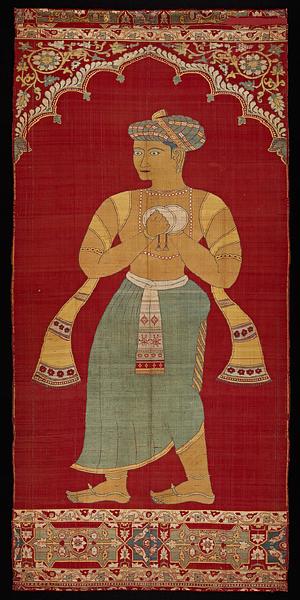Lampas-woven textile, silk. “Musician with cymbals”
India; c. 1600–1620
H: 201.5; W: 97 cm
This textile, just over two meters tall, was presumably woven in one of the Great Mughal’s studios to be sewn together with similar pieces to decorate a princely tent.
A highly Indian niche encloses a musician who can be seen from both the front and the side. He wears a typical Mughal turban, two shawls, and a loincloth (dhoti). Very much alive yet statue-like, he must have made a fantastic impression alongside other figures.
There are two related tent panels (qanat), one with an elegant courtier in the Los Angeles County Museum of Art and another with a female harem guard in the Khalili Collection in London. Both, however, are in rather poor condition.
Making such large and complex figurative textiles without repeating the motif requires a true overview of the whole, and they were hardly surpassed anywhere in their day.
The tent panel most likely comes from the Amber Palace in Jaipur.
Inv. no. 19/2011
Published in:
Francesca Galloway: Imperial past: India 1600-1800, Galloway, London 2011, pp. 2-5;
Rahul Jain: Indian lampas-weave silks in the collection of the Calico Museum of Textiles, Ahmedabad, Ahmedabad 2013, mentioned p. 26;
Steven Cohen: “Two outstanding Mughal qanat panels in the David Collection, with technical analyses and drawings of weaving structures by Anne-Marie Keblow Bernsted” in Journal of the David Collection, 4, 2014, p. 170, figs. 1, 7 and 13;
Louise W. Mackie: Symbols of power: luxury textiles from Islamic lands, 7th–21st century, Cleveland 2015, fig. 10.6, p. 414;
Rosemary Crill (ed.): The fabric of India, Victoria & Albert Museum, London 2015, fig 106, p. 104:
Ole Zethner [et al.]: South Asian ways of silk: a patchwork of biology, manufacture, culture and history, Guwahati, Assam 2015, p. 123;
Rahul Jain: Textiles and garments at the Jaipur court, New Delhi 2016, cat.no. 5, pp. 44-45;
Kjeld von Folsach, Joachim Meyer: The Human Figure in Islamic Art – Holy Men, Princes, and Commoners, The David Collection, Copenhagen 2017, cat.no. 16;
